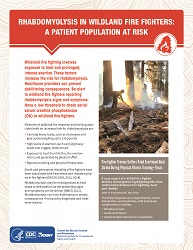Rhabdomyolysis in Wildland Fire Fighters: A Patient Population at Risk
May 2018
DHHS (NIOSH) Publication Number 2018-132

Wildland fire fighting involves exposure to heat and prolonged, intense exertion. These factors increase the risk for rhabdomyolysis. Healthcare providers can prevent debilitating consequences. Be alert to wildland fire fighters reporting rhabdomyolysis signs and symptoms. Have a low threshold to check serial serum creatine phosphokinase (CK) in wildland fire fighters.
Elements of wildland fire response and training associated with an increased risk for rhabdomyolysis are:
- Carrying heavy loads, such as chainsaws and gear packs weighing up to 110 pounds
- High levels of exertion, such carrying heavy loads over rugged, steep terrain
- Exposure to heat from the fire, the environment, and generated by physical effort
- Rigorous training and physical fitness tests
Rhabdomyolysis in Wildland Fire Fighters: A Patient Population at Risk [PDF – 4 MB]
